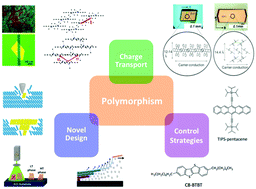Polymorphism as an emerging design strategy for high performance organic electronics
Abstract
Organic electronics is a promising field spanning a wide range of applications, with unrivaled advantages in low production cost, versatility in material synthesis, and compatibility with a wide range of substrates including flexible polymeric materials. Organic molecules are characterized by weak van der Waals interactions, which grant access to multiple crystalline packing states (crystal polymorphism) at near ambient conditions. Different polymorphs, even with the slightest changes in their molecular packing can have electronic properties that differ by orders of magnitude. Therefore, accessing metastable polymorphs can serve as a novel design strategy for attaining high device performance. Recently, this strategy has been successfully applied to small organic molecules such as 6,13-bis(triisopropylsilylethynyl)pentacene (TIPS-pentacene) and 2,7-dioctyl[1]benzothieno[3,2-b][1]benzothiophene (C8-BTBT) and high hole mobilities have been attained in organic field-effect transistors fabricated using their metastable structures. In addition, polymorphism serves as an excellent platform for advancing the fundamental understanding of charge transport in π-conjugated systems. The relationship between molecular packing and charge transport can be unequivocally established since the chemical structures are identical amongst polymorphs, leaving molecular packing as the only variable in the case of packing polymorphism.

- This article is part of the themed collection: Emerging Investigators 2016: Novel design strategies for new functional materials

 Please wait while we load your content...
Please wait while we load your content...